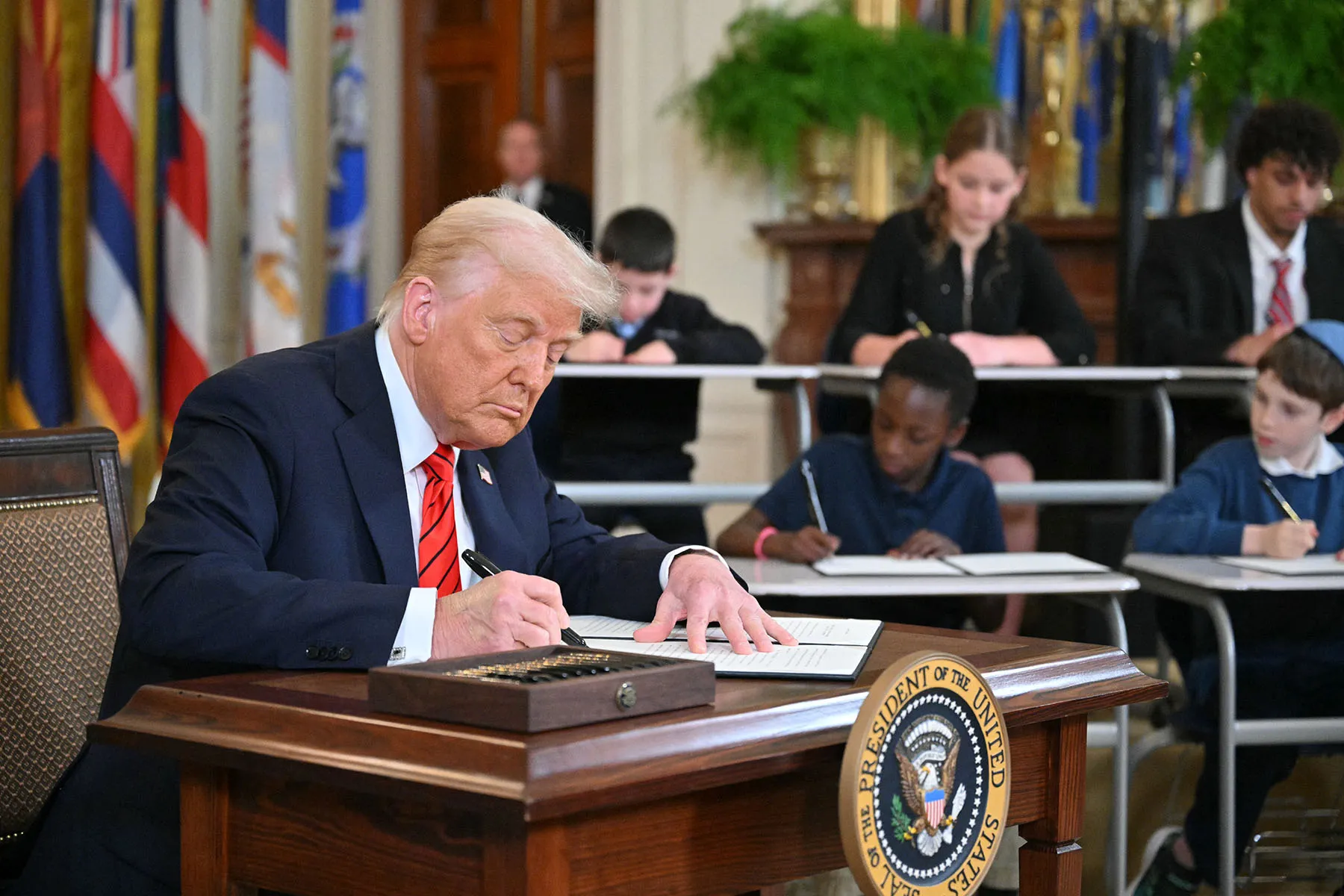President Donald Trump signed an executive order Thursday calling for the dismantling of the Department of Education in a move he said was 45 years in the making, referring to the agency’s founding in October 1979.
“People have wanted to do this for many, many years, for many, many decades and … no president ever got around to doing it, but I’m getting around to doing it,” he said.
He announced his long-anticipated plan to eliminate the agency before an audience of prominent Republicans including Texas Gov. Greg Abbott, Florida Gov. Ron DeSantis, Iowa Gov. Kim Reynolds, Texas Attorney General Ken Paxton and Tiffany Justice, cofounder of the conservative parental rights group Moms for Liberty. Education Secretary Linda McMahon was also in the audience and will “take all necessary steps to facilitate the closure of the Department of Education and return authority over education to the States and local communities,” according to the order.
“Linda, you’re presiding over something that’s so important, and you’re going to do a fantastic job just like you have your whole life,” he told her. “Hopefully, you won’t be there too long,” he said, referring to her role at the department, “but we’re going to find something else for you, Linda.”
He later kissed McMahon on the forehead after posing for photos with her. McMahon led the Small Business Administration during Trump’s first term and chaired his Super PAC, America First Action.
Before and after his 2024 presidential run, Trump vowed repeatedly to shut down the federal agency, fulfilling a longtime goal of many conservatives, but to do so lawfully, he needs congressional approval. Since Congress created the department, only an act of Congress can abolish it. Many of Trump’s moves to reshape the federal government have been blocked in court because judges have ruled he is overstepping his authority, and this move, too, is likely to face lawsuits.
The plan to dismantle the Department of Education is in Project 2025, the blueprint for a second Trump term drafted by conservative think tank the Heritage Foundation. While campaigning, Trump denied any connection to Project 2025, which faced heavy criticism, including for its goal to eliminate the sole federal education agency. Critics of closing the department say that it will hurt economically disadvantaged youth, children with disabilities and students who need financial aid for college since the agency administers funding to serve these groups.
During the White House ceremony — which featured a makeshift classroom, complete with students in school uniforms sitting in desks in front of the president’s podium — Trump said funding resources related to vulnerable populations of students “will be preserved and fully preserved.”
“They’re going to be … redistributed to various other agencies and departments that will take very good care of them,” he said.
The executive order states that the “delivery of services, programs, and benefits on which Americans rely” will not be interrupted by the agency’s dismantling.
“Should I do this?” Trump asked one child before signing the document. The boy nodded.
Trump has said that he wants to abolish the department because students’ standardized test scores have fallen consistently and because he would like states to have more control over public education.
“We want to return our students to the states, where just some of the governors here are so happy about this,” he said Thursday. “They want education to come back to them, to come back to the states, and they’re going to do a phenomenal job.”
He left out that states already set curriculum and learning benchmarks. While the Department of Education monitors the academic performance of students through tests such as the National Assessment of Educational Progress (NAEP), widely known as the Nation’s Report Card, it does not determine what students learn or the quality of what they learn. States do. The executive order acknowledged that “the Department of Education does not educate anyone” but argued that the agency is too costly to maintain. Trump’s critics contend he actually wants to close the Department of Education to privatize education, a shift they say would benefit the wealthy.
This is a dark day for the millions of American children who depend on federal funding for a quality education, including those in poor and rural communities with parents who voted for Trump.”
Derrick Johnson
“After 45 years, the United States spends more money on education by far than any other country, and spends, likewise, by far, more money per pupil than any country, and it’s not even close, but yet we rank near the bottom of the list in terms of success,” Trump said. “It’s an amazing stat.”
While reports from both right and left-leaning sources indicate that the United States spends more on education than comparable countries, others say that this is a myth. According to the National Center for Education Statistics, the United States ranked fifth worldwide in education expenditures in 2019.
The executive order points out that this year’s NAEP scores revealed that 70 percent of 8th graders aren’t proficient in reading, while 72 percent aren’t proficient in math.
The order comes a week after the Department of Education announced that it would eliminate nearly 50 percent of the agency’s staff, including about half the workers in the Office of Federal Student Aid, which oversees student loans. Many workers in the Office for Civil Rights (OCR), which investigates claims of discrimination, also lost their jobs. The main duty of the department is to ensure all students have equal access to education. In February, Elon Musk’s cost-cutting team slashed hundreds of millions of dollars to its Institute of Education Sciences, where research on student learning outcomes and other issues was conducted.
“If successful, Trump’s continued actions will hurt all students by sending class sizes soaring, cutting job training programs, making higher education more expensive and out of reach for middle class families, taking away special education services for students with disabilities, and gutting student civil rights protections,” Becky Pringle, president of the National Education Association, the country’s largest labor union, said in a statement. “In moving forward with this, Trump is ignoring what parents and educators know is right for our students.”
Trump called out teachers during his announcement, saying that his administration would take care of them, whether or not they are union members. He suggested that states would give teachers merit pay should they improve student outcomes. Merit pay has been a controversial issue in education, since educators who teach disadvantaged children face more difficulties in raising their test scores. While diversity, equity and inclusion (DEI) programs are designed to help such children, the Trump administration has staunchly opposed such policies. Accordingly, the executive order threatens to withhold federal funding from any education program or activity that engages in DEI or promotes what the White House calls “gender ideology,” alluding to transgender or nonbinary gender identities.
Rebecca Yates, an attorney for the Department of Education’s Office for Civil Rights, said she recently received an email informing her that the Trump administration was eliminating her division and position imminently. The downsizing of the agency has led to plans to close the Office for Civil Rights’ divisions in cities including Chicago, San Francisco, Dallas and New York. Those concerned about the closures say they leave students vulnerable to being discriminated against with little recourse.
The Department of Education “enforces civil rights laws that prohibit discrimination in the educational environment,” Yates said in a statement. “These three main laws are Title IX, which prohibits sex discrimination; Title VI, which prohibits racial discrimination; and Section 504, which prohibits disability discrimination.”
Heather Schwindt, an advocate for students and mother of two children with disabilities, recalled how schools historically denied education to disabled children. She said closing the Department of Education represents a step back for public education and threatens funding for the Individual Disabilities Education Act and Section 504 of the Rehabilitation Act, which guarantee students with special needs — including students with disabilities and other health-related concerns — an education that is free and appropriate for them.
“Reduced staffing, larger special education caseloads and reduced capacity for delivering specialized services will result in a reduction of federal funding for special education,” she said in a statement.
Derrick Johnson, president of the NAACP, an advocate for civil rights in education today and historically — most notably in the landmark Supreme Court case Brown v. Board of Education, which led to the desegregation of public schools — said the executive order calling for the Department of Education’s dismantling is unconstitutional.
“Trump is not just seeking to shut down an agency, he is deliberately dismantling the basic functions of our democracy, one piece at a time,” he said in a statement. “This is a dark day for the millions of American children who depend on federal funding for a quality education, including those in poor and rural communities with parents who voted for Trump.”
Trump only cares about the billionaires who stand to profit from privatizing education and other essential services, according to Johnson, whose organization advocates for student debt relief too. Trump has advocated for the Department of Education’s dismantling and for vouchers that give families taxpayer dollars to send their children to private schools. But an estimated 90 percent of K-12 students attend public schools, making the elimination of the Department of Education a risky political decision for the president.
Trump said during the ceremony that his plan to scrap the agency “is a very popular thing to do.”
A majority of likely voters object to closing the Department of Education, according to a recent poll by Data for Progress, a progressive think tank and polling firm. The poll of 1,294 likely voters conducted from January 31 to February 2 found that 48 percent strongly oppose eliminating the agency while 17 percent strongly support shuttering it. The poll was completed on behalf of Groundwork Collaborative, which works toward economic equity, and the Student Borrower Protection Center, which focuses on improving the student loan system.
The Student Borrower Protection Center has teamed up with law firm Berger Montague to represent labor union the American Federation of Teachers in a lawsuit filed Tuesday against the Department of Education over the agency’s handling of the student loan system. The complaint accuses the department of withholding affordable loan payment options to borrowers and preventing others from enrolling in the Public Service Loan Forgiveness program, which offers relief to public servants like teachers, social workers and nurses.
“By effectively freezing the nation’s student loan system, the new administration seems intent on making life harder for working people, including for millions of borrowers who have taken on student debt so they can go to college,” AFT President Randi Weingarten said in a statement. “The former president [Biden] tried to fix the system for 45 million Americans, but the new president is breaking it again.”





